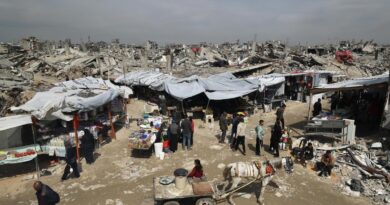U.S. optimism over Israel-Hamas cease-fire set for a test with new round of talks in Cairo
Tel Aviv — A new round of urgent talks aimed at hammering out a cease-fire agreement between Israel and Hamas was expected to kick off Thursday in Cairo — a follow-up to quickly-announced negotiations held last week in Doha. The results may show whether the optimism projected by the White House over the past week has been based more in reality, or wishful thinking.
One of the biggest sticking points between Israel and Hamas getting attention ahead of the talks was whether Israel would agree to pull back its military from Gaza’s southern border with Egypt — the so-called Philadelphi Corridor.
President Biden had been expected to push Prime Minister Benjamin Netanyahu to agree to that shifting of forces on his call with the Israeli leader Wednesday evening. But on Israeli TV, Netanyahu rebuffed a report in the Washington Post saying he would pull the troops back from the border zone as “not true.”
Netanyahu has stressed for months that Gaza’s southern border must be closed and controlled by Israel to ensure that Hamas cannot smuggle in weapons via Egypt. Israeli Defense Minister Yoav Gallant said Wednesday that Israeli forces had destroyed more than 150 Hamas tunnels in the border corridor, but Egyptian officials have rejected Israeli claims that significant material support for Hamas comes via that route.
Sima Shine, a top Israeli expert on Iran who worked previously for the country’s Mossad intelligence agency, told CBS News that if the cease-fire talks fail, then “not long after that we’ll see, especially Israel and Hezbollah in a military-wide conflict,” with Israel pulling in the United States.
Washington is Israel’s most important backer and, as of last year, the U.S. had more than 30,000 troops stationed across the Middle East, according to the Department of Defense. Since Hamas sparked the ongoing war in Gaza with its Oct. 7 terrorist attack on Israel, the U.S. military presence in the region has increased significantly.
Shine said Iran’s so-called “Axis of Resistance” includes proxy groups Hezbollah in Lebanon, Hamas in Gaza, the Houthis in Yemen and a number of militias in Iraq, Afghanistan, Pakistan and Syria, which, “if we combine them all together,” amounts to “hundreds of thousands” of fighters.
CBS News
While many Americans likely consider Iran the biggest security threat to Israel — and Israeli officials regularly refer to the Islamic republic in those terms — Shine says it’s Iran’s Hezbollah allies in Lebanon who represent the most immediate threat.
“Hezbollah is close to our borders. It is not Iran 1,600 kilometers (1,000 miles) from Israel. It’s completely different. The military estimates it [Hezbollah] has around 150,000 rockets and missiles. They have precise missiles. This could be a devastating attack on Israel. No question.”
A readout from the U.S. Embassy in Israel of Wednesday’s call between Mr. Biden and Netanyahu notably highlighted the bolstered U.S. military presence in the region. More F-18 and F-22 warplanes, more naval destroyers, a submarine armed with Patriot missiles and the USS Abraham Lincoln aircraft carrier strike group with F-35 fighter jets that arrived Wednesday from the Pacific all show that Washington stands ready to help defend Israel.
The talks in Cairo are expected to last through the weekend. Israel and Hamas have accused each other of sabotaging the negotiations for months. The U.S. said early this week that Israel had accepted a so-called bridging proposal — suggestions to close the supposed final gaps between demands from both sides — to get a deal done, but with some changes made.
OMAR AL-QATTAA/AFP/Getty
Hamas says it wants to work off an earlier, July 2 proposal that was supported then by the U.S. and the United Nations. The militant group accuses Israel of changing the terms in that proposal — and the U.S. of accepting those changes due to a pro-Israel bias.
The health ministry in the Hamas-run Gaza Strip says Israel’s war has killed more than 40,200 people, though it does not distinguish between combatant and civilian casualties. That toll includes 42 deaths and 163 injuries recorded over the previous 24 hours alone, the ministry said Thursday.
Hamas’ Oct. 7 attack on Israel saw the militants kill about 1,200 people and take some 250 others hostage, about 80 of whom are still believed to be held alive in Gaza.








